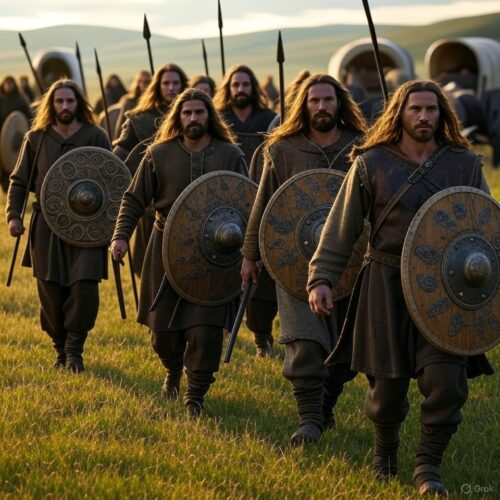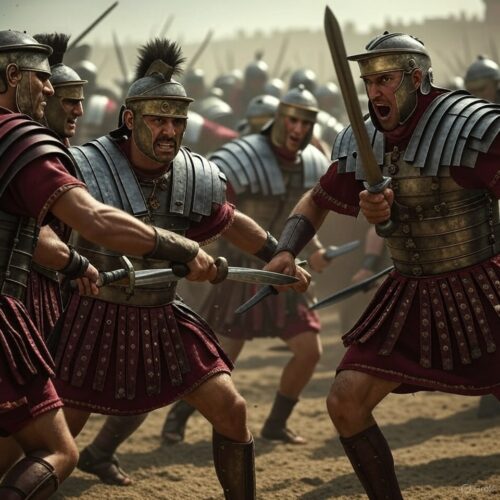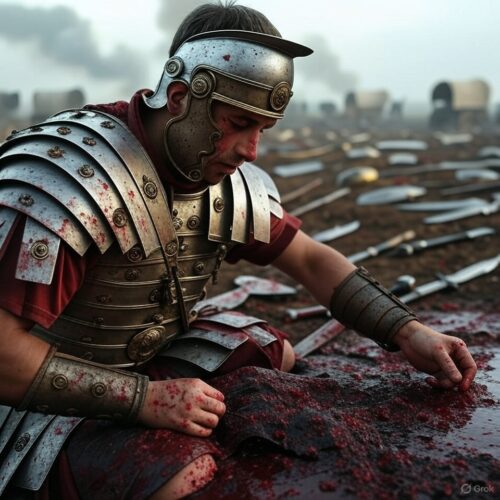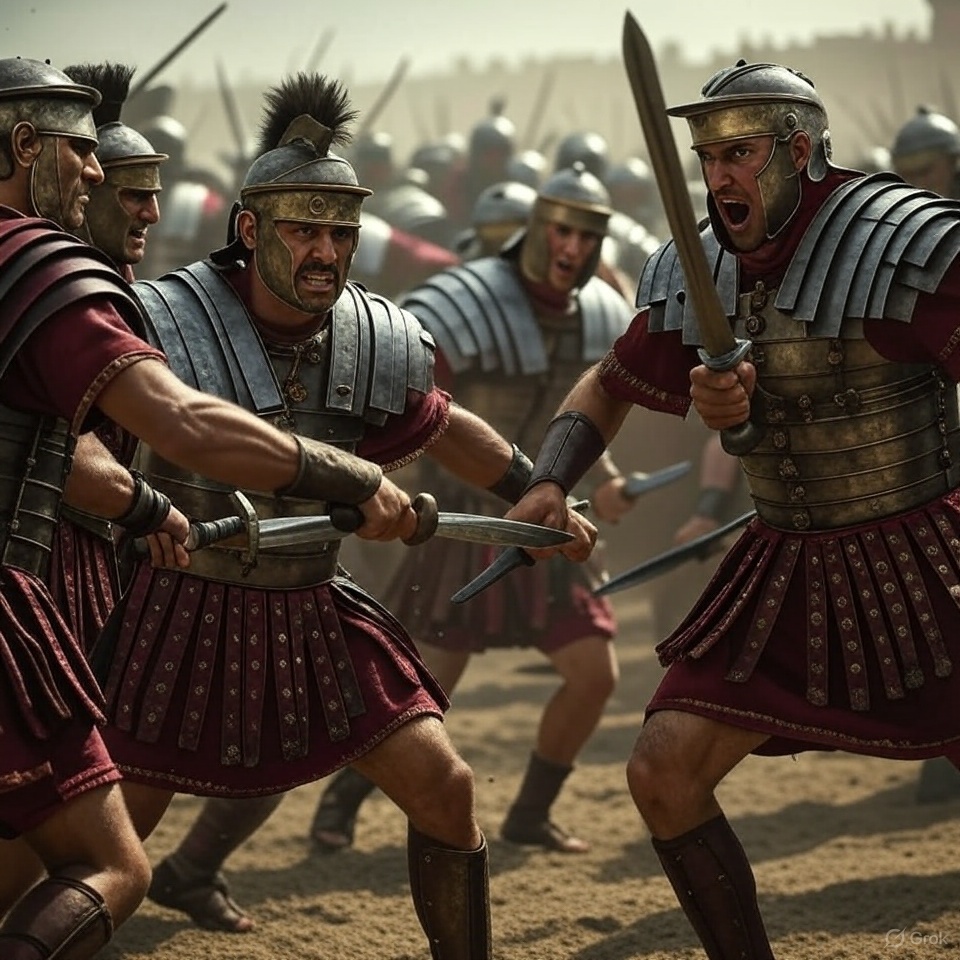Imagine a vast, dusty plain in northern Italy, where the fate of an empire hung in the balance under a scorching July sun. On July 30, 101 BC, the Battle of Vercellae unfolded—a clash that pitted the disciplined legions of Rome against the ferocious hordes of the Cimbri tribe. This wasn’t just another skirmish in the annals of ancient warfare; it was a pivotal moment that halted a barbarian invasion threatening to overrun the Roman Republic. Often overshadowed by more glamorous battles like Cannae or Zama, Vercellae stands as a testament to strategic brilliance, military reform, and sheer determination. In this blog, we’ll dive deep into the historical intricacies of this epic confrontation, exploring its background, key players, tactical maneuvers, and lasting impact. Then, we’ll bridge the centuries to uncover how the lessons from this distant victory can supercharge your personal growth today. Get ready for a journey that’s equal parts thrilling history lesson and motivational rocket fuel!

The story of the Battle of Vercellae doesn’t start on that fateful day in 101 BC. To truly appreciate its significance, we need to rewind the clock to the late 2nd century BC, when the Roman Republic was at the height of its power but teetering on the edge of crisis. Rome had conquered vast territories, from Spain to Greece, but its military system was showing cracks. The legions were traditionally composed of citizen-soldiers—property-owning farmers who served seasonally. However, prolonged wars had depleted this class, leading to recruitment issues and declining morale.
Enter the Germanic tribes, particularly the Cimbri and their allies, the Teutons and Ambrones. These weren’t your typical raiders; they were entire peoples on the move, driven south from their homelands in Jutland (modern Denmark) by environmental pressures like flooding and overpopulation. Ancient sources, such as Plutarch in his “Life of Marius,” describe them as a massive migratory force, numbering in the hundreds of thousands, including warriors, women, children, and wagons laden with belongings. The Cimbri were tall, fair-haired warriors known for their ferocity, often fighting naked or in minimal armor to display bravery, wielding long spears, swords, and shields adorned with animal motifs.
Their migration turned into a nightmare for Rome beginning in 113 BC. That year, the Cimbri invaded Noricum, a region allied with Rome inhabited by the Taurisci people. The Roman consul Gnaeus Papirius Carbo was dispatched to repel them but suffered a humiliating defeat at the Battle of Noreia. The invaders then veered west into Gaul, clashing with Roman forces repeatedly. In 109 BC, they routed Consul Marcus Junius Silanus. Two years later, in 107 BC, Consul Lucius Cassius Longinus achieved a temporary victory against the Cimbri’s allies, the Volcae Tectosages, near Tolosa (modern Toulouse), capturing a hoard of gold rumored to be cursed—the infamous “Gold of Tolosa.” But Longinus was soon ambushed and killed at the Battle of Burdigala (Bordeaux).
The low point came in 105 BC at the Battle of Arausio (near modern Orange, France). Here, Roman internal rivalries proved disastrous. Two consuls, Quintus Servilius Caepio and Gnaeus Mallius Maximus, refused to cooperate due to social class differences—Caepio, a patrician, snubbed the “new man” Mallius. The Cimbri and Teutons exploited this division, annihilating the Roman armies in what Plutarch calls Rome’s worst defeat since the Second Punic War. Estimates suggest 80,000 to 120,000 Roman soldiers perished, along with 40,000 camp followers. Panic gripped Rome; rumors spread of barbarians at the gates, evoking memories of the Gallic sack in 390 BC.
In this atmosphere of dread, the Roman people turned to Gaius Marius, a novus homo (new man) from a humble background in Arpinum. Marius had proven himself in the Jugurthine War in North Africa, where he captured the Numidian king Jugurtha through cunning diplomacy and warfare. Elected consul in 104 BC—an unprecedented fifth consecutive term—Marius was tasked with saving the Republic. He immediately set about reforming the army, a move that would revolutionize Roman military history.
Marius’ reforms were groundbreaking. He opened recruitment to the capite censi, the propertyless poor, providing them with state-funded equipment and promising land upon retirement. This created a professional standing army loyal to their general rather than the state, laying seeds for future civil wars but proving essential in the short term. He standardized training, introducing the “Marian mule”—soldiers carrying their own gear to increase mobility. The cohort replaced the manipular system, with legions organized into 10 cohorts of 480 men each, enhancing flexibility. Marius also adopted the aquila (eagle) as the legion’s standard, fostering unit pride.
By 102 BC, Marius was ready. The Teutons and Ambrones, separated from the Cimbri, advanced into Provence. At the Battle of Aquae Sextiae (Aix-en-Provence), Marius ambushed them. He hid 3,000 men under Marcus Claudius Marcellus in a nearby wood. As the main battle raged, the ambush struck the enemy rear, causing panic. The Teutons were slaughtered; their king Teutobod was captured, and according to Livy, over 100,000 were killed or enslaved. Women of the tribe, in a display of defiance, slew their children and themselves rather than face captivity.
Meanwhile, the Cimbri, under King Boiorix, crossed the Alps into northern Italy, bypassing Quintus Lutatius Catulus’ defenses at the Adige River. Catulus, Marius’ consular colleague, retreated to avoid destruction, but this allowed the Cimbri to ravage the Po Valley. They wintered there, enjoying the fertile lands but reportedly growing soft on Italian wine and bread, as per Plutarch’s accounts.
In 101 BC, Marius, fresh from his triumph over the Teutons, marched north to join Catulus. Their combined force totaled around 52,000 men: 32,000 under Marius (veterans from Aquae Sextiae) and 20,000 under Catulus (less experienced troops). The Cimbri, eager for battle, sent envoys demanding land for settlement. Marius refused, mocking them by parading captured Teuton kings in chains. Boiorix chose the Raudine Plain near Vercellae (modern Vercelli) for the confrontation—a broad, open field ideal for their numerical superiority, estimated at 120,000 to 180,000 warriors, though ancient figures are often inflated.

As July 30 dawned, the plain was shrouded in fog, adding an eerie atmosphere. Marius positioned his army facing west, ensuring the rising sun and wind-blown dust would blind the Cimbri. He placed his seasoned troops on the wings, with Catulus’ men in the center—a risky but calculated move to draw the enemy in. Lucius Cornelius Sulla, Marius’ quaestor and future rival, commanded the cavalry on the right. The Romans vowed sacrifices to the gods for victory; Marius promised to offer 100 white oxen to Hercules.
The Cimbri emerged in a massive square formation, their front line reportedly a mile wide and deep, chained together at the waist to prevent flight—a tactic noted by Florus. Their 15,000 cavalry, adorned with helmets resembling wild beasts, charged first, but the fog and dust caused confusion. Boiorix led the infantry in a wedge aimed at Catulus’ center, hoping to break through.
The battle erupted with Roman pila (javelins) raining down, disrupting the Cimbri advance. The heat was intense; the northern warriors, unaccustomed to it, sweated profusely under their furs and armor. As the Cimbri cavalry veered right to outflank, they clashed with Sulla’s horsemen. The dust storm intensified, obscuring vision—Plutarch describes it as a “fight in the fog.” Marius’ left wing pursued the fleeing Cimbri cavalry into the haze, temporarily losing contact.
In the center, Catulus’ legions held firm against the onslaught. The Cimbri, packed tightly, couldn’t maneuver, their long weapons ineffective in close quarters against Roman gladii (short swords). As Marius’ wing returned, they struck the Cimbri flank, turning the tide. Panic spread; the Germanic line collapsed.
The rout was horrific. The Cimbri retreated to their wagon laager, where women defended fiercely, hurling axes and spears from atop the carts. When defeat became inevitable, many women killed their children, then themselves—Orosius recounts scenes of mothers dashing infants against rocks and strangling them with their hair. Boiorix and his nobles fought to the death in a last stand.
Casualties were staggering. Ancient sources vary: Plutarch claims 120,000 Cimbri dead and 60,000 captured; Livy ups it to 140,000 dead. Roman losses were minimal—perhaps 300, as per some accounts, though likely higher. The field was littered with bodies; vultures feasted for days. Captives included leaders Claodicus and Caesorix; Lugius was slain.

In the aftermath, Marius was hailed as the “Third Founder of Rome,” celebrated with a triumph where he and Catulus shared honors, though Marius took the lion’s share of glory. He dedicated spoils to the gods, including Boiorix’s armor. The victory ended the Germanic threat, securing Italy’s northern borders for generations. However, it highlighted tensions: Catulus accused Marius of downplaying his role, foreshadowing future rivalries.
The battle’s legacy extended beyond immediate security. Marius’ reforms professionalized the army, enabling Rome’s imperial expansion but also contributing to the Republic’s downfall, as soldiers’ loyalty shifted to generals like Sulla, Pompey, and Caesar. Vercellae marked the end of the Cimbrian War, a conflict that tested Rome’s resilience and spurred innovation.
Historians debate details due to biased sources. Plutarch, writing centuries later, relied on Sulla’s memoirs, which may exaggerate his contributions. Archaeological evidence is scarce; the plain’s location is approximate, near the Sesia River. Some scholars question the Cimbri’s numbers, suggesting 50,000-80,000 as more realistic. Debates also surround the tribes’ origins—were they Celtic or Germanic? Linguistic evidence leans Germanic, but alliances blurred lines.
Vercellae wasn’t just a military win; it symbolized Rome’s adaptability. The Republic, reeling from defeats, reinvented itself through Marius’ vision. This underappreciated battle prevented a potential collapse, allowing Rome to flourish into the empire we romanticize.

Shifting gears from ancient dust to modern hustle, what can we glean from Vercellae to supercharge our lives? The battle’s outcome—triumph through reform, strategy, and resilience—offers profound benefits. By applying these historical facts, you can transform personal challenges into victories. Here’s how this distant event directly benefits you today:
– **Enhanced Preparedness for Life’s Invasions**: Just as Rome faced the Cimbri’s unexpected migration, you encounter unforeseen obstacles like job loss or health issues. Learning from Marius’ reforms teaches proactive skill-building, turning vulnerabilities into strengths.
– **Strategic Thinking in Daily Decisions**: The battle’s tactical positioning—using sun and dust—mirrors using environmental factors to your advantage, like networking in career moves or timing investments.
– **Building Personal Loyalty and Teams**: Marius’ professional army fostered dedication; apply this by cultivating supportive relationships, ensuring your “legion” of friends and colleagues stands firm during tough times.
– **Resilience Through Adversity**: The Romans bounced back from Arausio’s catastrophe. This inspires viewing failures as setups for comebacks, boosting mental toughness.
– **Innovation in Routine**: Marius standardized equipment; modernize your habits, like adopting productivity tools, to streamline life.
To harness these, follow this actionable plan inspired by Vercellae:
- **Assess Your Threats (Week 1)**: Identify your “Cimbri”—list three major challenges. Research them like Marius scouted enemies, gathering info on solutions.
- **Reform Your Arsenal (Weeks 2-3)**: Overhaul one key area, e.g., if fitness is weak, join a gym and track progress like a Marian cohort.
- **Position for Victory (Week 4)**: Plan a “battle” strategy for a goal, using advantages like timing or resources. Execute a small test run.
- **Engage and Adapt (Ongoing)**: Tackle the challenge, adjusting tactics mid-way. Celebrate wins, no matter small, with a personal “triumph.”
- **Reflect and Secure Borders (Monthly)**: Review outcomes, reinforce successes, and prepare for next threats.
Embracing Vercellae’s spirit isn’t about reliving the past—it’s about igniting your future. This battle reminds us that empires, and individuals, rise not despite crises, but because of them. So, channel your inner Marius, reform boldly, and conquer!


